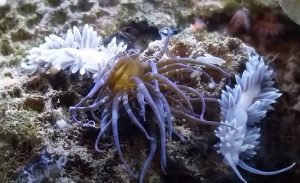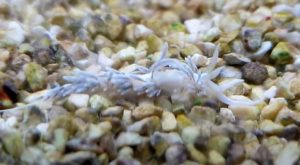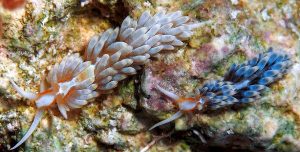The Berghia nudibranch (Berghia stephanieae) is one the more common species of miniature sea slugs found throughout warm and temperate waters of the Atlantic Ocean, Carribbean, and Mediterranean seas.
In North America, the Berghia nudibranch is one of the most commonly sold Aeolid nudibranchs in the fish keeping hobby. Huge populations are annually collected from the Florida Keys and sold to reef keepers to rid their tanks from pesky aiptasia anemones.
In their natural habitat, Berghia stephanieae are natural predators of the Aiptasia anemone which is their only diet.
Tropical fish keeping enthusiasts prize the Berghia nudibranch because they are harmless to corals and will effectively remove the worst infestations of aiptasia anemones from a reef tank.
The Berghia nudibranch is a small sea slug that is readily identified by its white or semi translucent body and conspicuous head with two long tentacles (chemoreceptors) that are used to test food. Behind the tentacles are rhinophores, that look like the two oral tentacles, but are visibly shorter, and help the nudibranch detect distant food sources in the environment. The light sensory eyes of Berghia stephanieae are normally located behind the rhinophores, and are are capable of rudimentary vision.
The multiple protrusions or tassels at the back of the Berghia nudibranch called cerata, are an extension of their digestive system; facilitate oxygen exchange, and act as a defense mechanism to the slug. The nematocysts they contain are absorbed from the consumed Aiptasia anemones they feed on.
The Berghia nudibranch absorbs immature stinging cells from Aiptasia anemone and allows them to mature within itself, making it capable of releasing the cerata containing stinging cells at will to ward off aggressive predators.
Through symbiosis, Berghia nudibranch are able to hold (zooxanthellae) the same photosynthetic symbiotic algae found in corals, that they get from ingesting Aipasia, and use it for short periods as an alternative food source. However, for long term survival, they require an ample supply of Aiptasia to survive.
The Berghia nudibranch is best housed in aged reef tanks with infestations of Aipasia, plenty of live rock for them to hide among, and low to moderate water flow. Because they thrive in small colonies and are more effective at eliminating Aiptasia in groups, it is highly recommend to introduce at least 3 to 8 individuals into a 50 gallon reef tank at one time.
Do not keep them with large aggressive species like wrasses or carnivorous shrimp which may pick at them or eat their eggs. Butterfly fish, Long Nosed Hawkfish, Filefish, Camel shrimp (Rhynchocinetes durbanensis), Coral banded shrimp, Sally lightfoot crabs, Arrow crabs, and Emerald crabs are known to prey on Berghia nudibranchs. Peppermint shrimp and Boxer Crabs (Lybia tesselata) can also pose a threat.
Berghia nudibranchs are fragile marine invertebrates that need proper acclimation to their new environment.
Float their container in your reef tank or sump for 15-20 minutes to acclimate water temperature.
Using a drip acclimation kit, drip aged aquarium water into the container at a drop rate of about 5 to 10 drops per second for an hour.
Instead of isolating each individual, place the Berghia nudibranchs in groups on a live rock 2 to 3 inches from Aiptasia anemones, away from heavy current in the tank.
Berghia stephanieae are hermaphrodites and will readily breed in an aquarium environment when sufficient Aipasia anemone are present. Because each nudibranch has both male and female reproductive organs, two are required for mating an fertilization of the eggs.
Berghia nudibranch reach maturity at two months of age. They usually lay their eggs on the underside of a live rock, under a large live coral, macroalgae, and occasionally on the wall of the aquarium. The eggs are laid into the form of a spiral strip called egg ribbon with an average of 50 to 80 eggs per strip.
A single adult is capable of producing over 1000 eggs in a single egg ribbon every one or two days. The eggs hatch out in about 10 to 14 days with the newly hatched offspring emerging as free swimming veliger larvae. The 200 micron size larvae turn into 600 micron sized juveniles in as little as 48 hours and will live up to a year with a constant food source. Because of their specific food requirements, competition for food plays a huge role in the breeding of Berghia nudibranch.
Berghia stephanieae are specialist predators that feed exclusively on Aipasia anemone that often plague saltwater reef aquariums. In the absence of predators, Berghia are able to cure any Aiptasia problem without disrupting the health and stability of your reef tank. Without a sufficient population of Aipasia, the sea slugs will eventually starve to death.
Instead of letting your population of Berghia nudibranchs die from starvation, pass them along to other tropical fish keeping enthusiasts who need them. A lot of reef keeping hobbyists who are battling with problem Aiptasia in their reef tanks may not be privy to how easy it is to eliminate an infestation; so selling or giving away some Berghia is handing them the solution on a golden platter.
Berghia nudibranch (Berghia stephanieae) are in high demand from tropical fish keeping enthusiasts and can be obtained from specialty fish shops, Nudibranch forums, and a variety of online sources at costs between $8.00 to $30.00 for a single specimen.
One Berghia nudibranch per 10 gallon of water is recommended for Aipasia infestations in reef tanks.
Minimum Tank Size: 30 gallons
Aquarium Type: Established Reef
Care Level: Easy
Temperament: Peaceful
Aquarium Hardiness: Relatively hardy
Water Conditions: 72-78°F, dKH 8 to 12, pH 8.1-8.4, sg 1.023-1.025
Max. Size: 1.5″
Color Form: White, Creame
Diet: Specialty Carnivore
Compatibility: Reef Compatible
Origin: Atlantic Ocean, Carribbean, Mediterranean
Family: Chromodorididae
Lifespan: 1 year
Aquarist Experience Level: Intermediate





